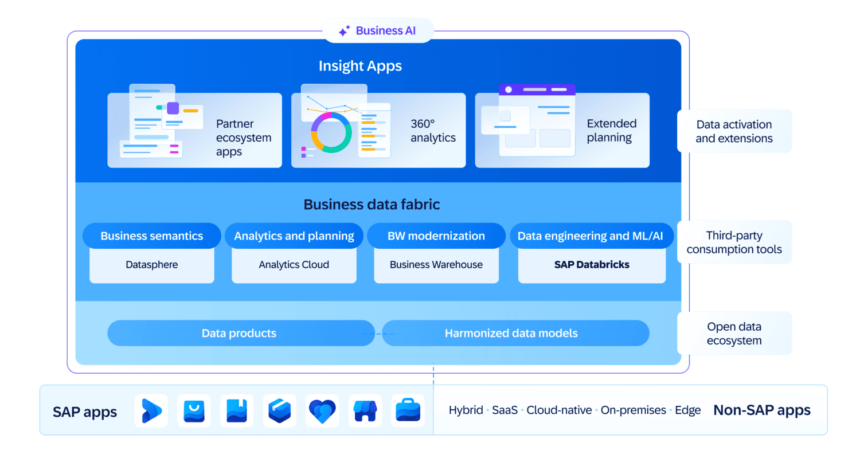Today, SAP announced the new Business Data Cloud product at the Business Unleashed event. This data platform lays the foundation for AI-driven decision-making. By bringing operational and external data together in an intelligent layer, the platform opens the door to faster analytics, smarter automation, and closer integration between IT and day-to-day operations. We spoke about the Business Data Cloud with CRO Americas and SAP Business Suite Jan Gilg shortly before the launch.
For those who use SAP’s data products, it is often clear that operational data hides many insights. Gilg points out that this is partly because most global trade touches an SAP system in one way or another. However, plenty of valuable information resides in other systems as well. Companies appear to struggle precisely with combining the operational data from SAP systems with data from other sources. There is still a huge mountain of business data that could be better utilized despite all the steps within the tech industry that have been taken to address it.
As far as SAP is concerned, the wheel needs to change toward a broader vision of the future of enterprise AI. The days when data was simply stored and later analyzed are behind us, and so SAP’s data portfolio is also shifting. After all, modern companies need an environment in which data actively contributes to optimizing processes, predicting market trends, and supporting real-time decisions.
The Business Data Cloud should become the missing link for any business. This is a platform where data is not only managed but also enriched and instantly deployable within AI-driven workflows. The right insights should emerge from this new environment.
Finding the perfect match
This accurate and reliable data can be useful in gaining insights and building AI apps. However, many AI models currently struggle with inconsistent or unstructured input. SAP can hopefully make progress by training AI on high-quality, semantically enriched data directly from core systems. After all, that translates into more reliable and context-aware AI that recognizes patterns and understands how they relate to business operations.
To achieve that in the right way, you’ll also have to look at how to set up the data foundation and infrastructure properly. SAP has built options for that itself, but there are absolute preferred products available on the market from companies. SAP thus ended up with an OEM partnership with Databricks. This creates a hybrid model in which companies can bring together, analyze and deploy data from different sources for AI-driven insights without friction or duplication. According to Gilg, Databricks makes additional sense because customers often already use SAP and Databricks products. “The customer reality shows that a lot run Databricks. We don’t want to go for rip-and-replace, but fit into a customer’s landscape,” Gilg said. The Business Data Cloud is thus natively integrated with Databricks’ lakehouse, allowing companies to combine SAP data and non-SAP data effortlessly.
Comprehensive data engineering options
SAP, through its partnership with Databricks, is also opening the door for users to embrace more data engineering. This platform streamlines how businesses process, transform and prepare data for AI and BI. Through native support for ETL (Extract, Transform, Load) processes, data engineers can structure and optimize raw data within a single integrated system. This reduces reliance on separate data warehouses and data warehouses, allowing companies to generate insights faster and spend less time on complex data processing.
We referred to this concept above as the lakehouse, something Databricks has been building and quickly becoming popular with recently. In the meantime, Databricks is talking more about the Data Intelligence Platform, which offers some additional options over the lakehouse but works similarly. It is what SAP is now using through an OEM partnership at the Business Data Cloud. Databricks can further accelerate data engineering processes through automation and optimization. With techniques like Delta Live Tables, data engineers can quickly build pipelines that automatically stay up-to-date and minimize errors. As a result, operational SAP and external data are available for analysis faster and remain more reliable and consistent across departments and applications.
The Data Intelligence Platform should make data engineering more powerful and accessible to a wider audience. Low-code and no-code functionalities allow data engineers, analysts, and business users with limited programming knowledge to model and transform data streams.
Tip: Databricks moves from lakehouse to data intelligence
Is the end of data silos near?
Gilg explains that in the past, enterprise data management was often a fragmented process, with silos of information spread across different departments and systems. SAP Business Data Cloud promises to break this barrier by creating a unified semantic layer where all relevant data comes together. Operational data remains in SAP, while other data resides in Databricks. In addition to better analysis, this should also form the basis for AI applications beyond static dashboards and reports. “It breaks down silos,” Gilg foresees. “The Business Data Cloud becomes the starting point where you build analytics and reports.”
One example is the Insight apps SAP plans to enable through the Business Data Cloud. These applications promise to help companies generate real-time insights and take immediate action. This is done by connecting data products and AI models with real-time data, giving users more accurate analysis and better planning. With the launch of Business Data Cloud, a finance Insight app will become available. By processing financial data in real-time and enriching it with AI models, companies can optimize cash flow, assess risks, and simulate the impact of decisions. Whereas traditional financial reporting often provides a look back at the past, AI allows for more forward looking and proactive action.
Ultimately, Gilg foresees much being possible on the Insight front. Because the Business Data Cloud has finance, spend and supply chain data from SAP S/4HANA and SAP Ariba, different scenarios are possible. Some things are also possible from the HR data from SAP SuccessFactors. The data from these SAP systems all keep their original business context and semantics without the need for data extraction first. The Insight apps run on top of the Business Data Cloud; users can take them from a central location. “Customers can subscribe to it and then build their own dashboards, plus through partners they have,” Gilg explains.
With this, SAP aims further to grow AI into an integrated part of business operations. This combined with the emergence of AI agents, automated assistants that can take over repetitive tasks in SAP and speed up processes. In this, the co-pilot Joule should have a coordinating role, as SAP promised during the Business Data Cloud presentation. The co-pilot directs these AI agents based on real-time business data, which should become further insightful via the Business Data Cloud. The agents can access the right data to perform tasks and make recommendations.
From data to strategy
With the introduction of SAP Business Data Cloud, SAP is taking a fundamental step toward a future in which AI, data and business processes form one integrated whole. That may sound like a familiar ambition to some SAP users. Indeed, the ERP giant launched Datasphere two years ago, expressing similar ambitions. When asked, Gilg indicated that the Business Data Cloud is an evolution of Datasphere and other SAP data products. As far as SAP is concerned, the Business Data Cloud will soon be the most logical and comprehensive option, to which customers will also naturally switch automatically. “Some concepts are very valid,” Gilg refers to previous data products. “What is new is to really offer it as a service and really offer users data products.”
All in all, the German software company still sees too many organizations struggling to combine operational data from SAP systems with data from other sources. That deserves a new approach for which SAP and Databricks are moving closer together. We are curious how this will play out further in the coming months.
Tip: SAP continues to build out AI capabilities S/4HANA, first steps with AI agents











